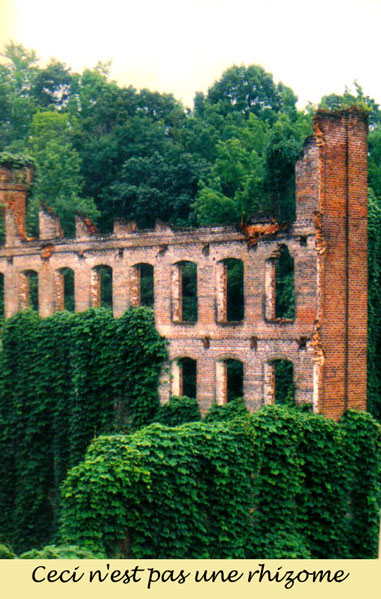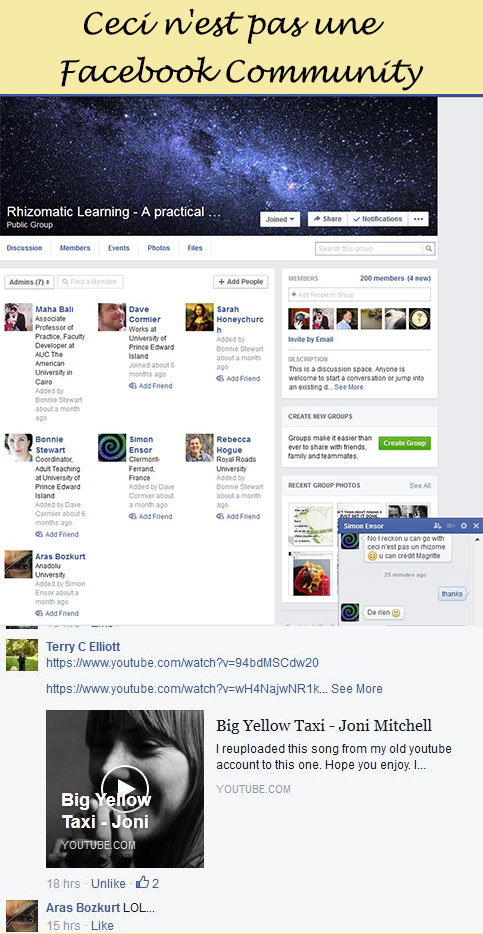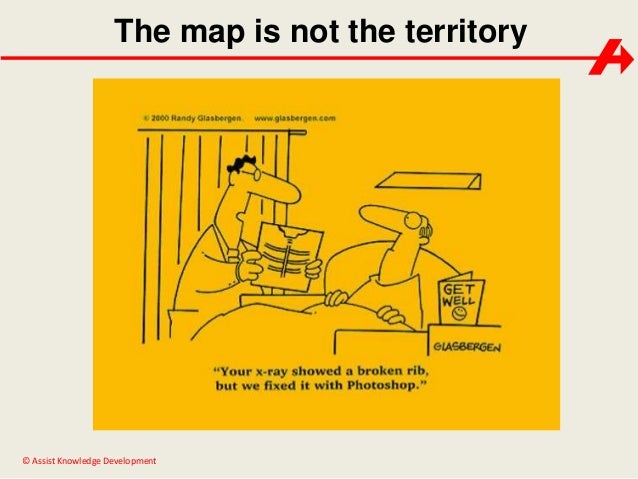Two competing thoughts are vying for my attention as I belatedly address Week Five’s question about invasive species. Dave asks if, in promoting rhizomatic learning, we are trading one authority structure for another. If we are in-grown. If we are destructive.

“wall and kudzu” by Neil Smith on Flickr http://bit.ly/1FzQ1XX
(CC BY-NC-SA 2.0)
My twin contentions are,
(A) that as proponents of Rhizomatic learning we are not doing harm,
(B) and anyhow, we were here first.
Regarding the first proposition:
- The Rhizome is a metaphor, not literally translated into learning practices by the ugly knotted roots of bishop’s weed or the choking weight of kudzu.
- We are reasonable, intelligent educators, not driven by biological imperative (Freud and male stereotypes notwithstanding) to insinuate our protuberances into every available crevice leaving no space or nutrients for contrarian ideas to thrive.
- Ourrhizomatic model of learning is manifested, not by a destructiveinvasiveness, but by the parallel processes of subterranean learning and a delightful “sudden” and unexpected manifestation of a skill beingutilized above the surface in a new space.
I was completely taken by one thing Dave Cormier said about his experiences in EdTechTalk with Jeff Lebow. (not a direct quote – think I heard it in a live webinar) Dave said, after being involved that conversation over a period of months, he found himself able to do things he was not previously able to do, without having consciously decided to learn them.
That encapsulates Rhizomatic Learning for me and has been my experience as well – granted, to a much more modest degree than what Dave manifests.
Gerald Ardito replied to the Week 2 question about what we could measure or count, by referring to Stephen Downes. Downes contends that we know when we have learned something when we are recognized by other practitioners in that field. I don’t know if it’s because they only hear me talking and don’t see how little I actually DO, but people at my college keep surprising me in the recognition they show for my innovations – and I learned it all indirectly/obliquely/rhizomatically through hanging out with all these great people online because they were fun and challenging, not because I had a particular learning objective. That’s invasive, but beneficial. - OK, that got long-winded for a simple list (and I addressed several weeks of Rhizo 15 topics)
- P.S.Delightfully Sidetracked below
Second proposition – I’ll pretend this is also a list
- Rhizomatic learning was here first. It is the natural way to learn. It is organic.
- I’ve referred to my childhood experiences with Asparagus in a response to Autumm Caines’ post The part of the garden where we planted our Asparagus crowns (rhoizomes) was home to a wild grass we called wire-grass – also a rhizome. I remember pulling up yard-long underground wire-grass runners in the softer areas of the patch where the neighbour’s sawdust pile (he built marvelous furniture) spilled over into our garden. No matter how many roots I pulled out, the grass always came back up. But then, no matter how many asparagus shoots we cut off to sell or eat, more also always sprang up from its roots. Even with child-labour, our family could barely keep down the native wire-grass to let the newcomer asparagus flourish. (invasive species aided by mercenaries?) My point is, the Rhizome was there before the cultured vegetable subjugated it for a profit.
- The truly invasive species that has infiltrated all spaces and strangles other learning initiatives is the structured, formalized, legislated educational system. (Apologies to Blake and Karen and Jackson, all my friends at the department of Education, Culture, and Employment – you are good people).
- There is a far greater danger of the established educational system strangling a novice rhizomatic learner than the other way around. It carries the crushing authoritative message of “that’s not the right way” and “that will never work“. It also has the power of money behind it.
P.S. Delightfully sidetracked – and return.
I thought I’d caught William Gibson channeling D&G in his final Blue Ant Trilogy novel “Zero History.” In ch 74 the character Milgrim compares the view on the penguin-drone controller interface on his iPhone to “a rectangular chip of London’s surface pried (up) … revealing a substrate of bright code” but then he realizes it’s the other way around. The city must be the code that underlay the iPhone view because, “the territory wasn’t the map”. I looked up the quote and found it wasn’t D&G after all, but Alfred Korzybski in 1931 who coined the phrase, “The map is not the territory.”
That led me to this charming comic which had me giggling like a three-year-old for a time.
 But I also found The Treachery of Images by René Magritte. Underneath his very realistic painting of a pipe, he wrote “This is not a pipe†“, which brought me full circle in my conviction about my first point. The rhizome is only a metaphor, or map, for the philosophy of learning which the Rhizo 15 community seeks to understand and promote. So, borrowing from Magritte, and reassured by Simon Ensor that the grammar is correct for my adaptation, there’s my trope at the top of the page. The metaphor is not the reality.
But I also found The Treachery of Images by René Magritte. Underneath his very realistic painting of a pipe, he wrote “This is not a pipe†“, which brought me full circle in my conviction about my first point. The rhizome is only a metaphor, or map, for the philosophy of learning which the Rhizo 15 community seeks to understand and promote. So, borrowing from Magritte, and reassured by Simon Ensor that the grammar is correct for my adaptation, there’s my trope at the top of the page. The metaphor is not the reality.
†Story goes, when someone challenged Magritte that his painting was indeed a pipe, that his disclaimer was wrong, he suggested they try to put tobacco into it.
And just as a bonus, here’s another riff on Magritte and Korzybski

The community is people
Actor Network Theory notwithstanding




Oops ur not lou! Ur Jim Stauffer!
Just read this, Lou, and LOVE IT. Love the images and all the points you bring together and agree _ rhizomatic is NATURAL. Everything else is imposed. It’s strange that it takes social media and new tech to bring the rhizomatic to the fore again, right?
really enjoyed this – i love the idea that what’s rhizomatic was here first… it seems like an idea worth pursuing that isn’t much pursued, or am i missing something there? and the last image for some reason is very moving, perhaps in relation to the others, and to the rhetoric that online is not authentic relationship.